The Best New York Style Pizza Dough and 14 Tips for Success!!
I’ve been making a lot of this NY style pizza dough recipe …. The obsession started a while back, and I’ve finally found a recipe that I love the best! After years of experiments (and I mean years!), I am now using this recipe based on recommendations from the many fine pizza makers at www.pizzamaking.com and the late great Dough Doctor, Tom Lehmann.

Making Pizza Dough at Home
Making NY style pizza dough is definitely somewhat of an art form. There are so many variables that can be changed aside from the ingredients alone. For example, these variables include:
- oven temperature
- temperature of the water used to make the dough
- proofing methods (room temp vs cold rise)
- order of adding the ingredients (yes, this makes a big difference!)
- mixing time
- use of autolyse
- use of poolish (I don’t do this or the one before, although I have in the past)
And then of course, the toppings which can be simple or as complex as you’d like. But don’t worry too much about all of this – my method is easy and straightforward. Plus, you will make better dough than 99% of the pizza chains out there. You will not want take out anymore!
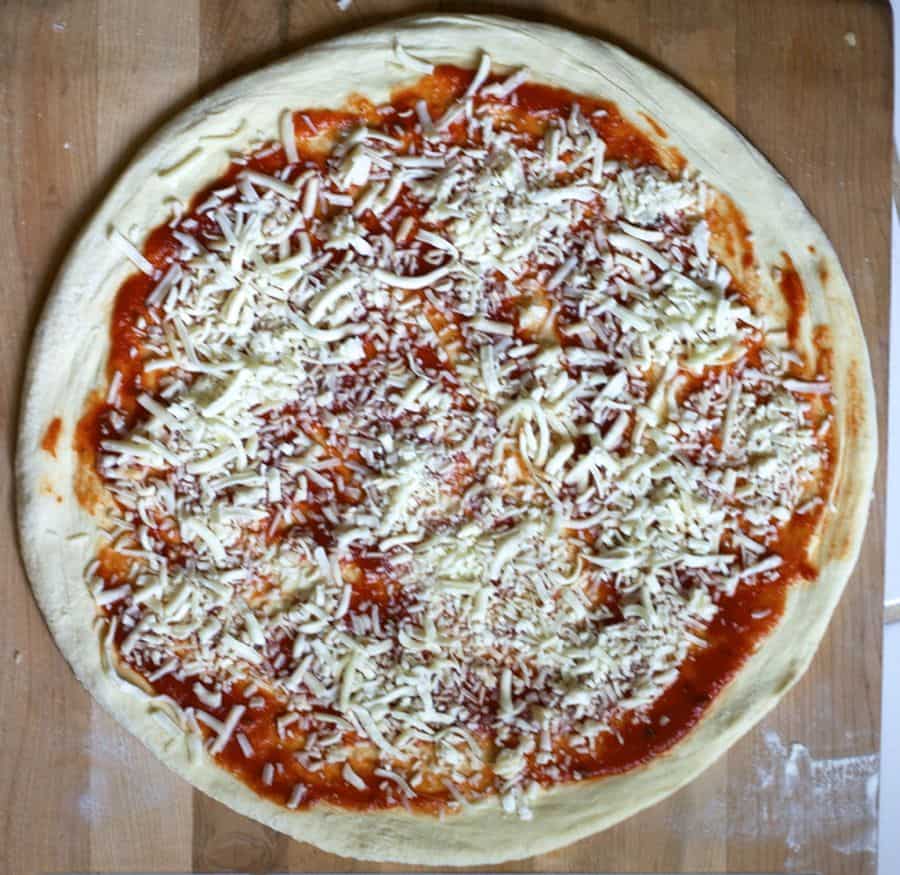
My Favorite Pizza Dough: The Big Secret (How You Proof the Dough)
My all-time favorite dough is NY style dough, which really is classic pizza dough that is stretched out into a thin crust pizza. This type of pizza dough contains water, flour, salt, instant yeast, and olive oil (and sugar especially when baking in a home oven, to help browning).
After it is mixed, it is proofed (left to rise/ferment) in the refrigerator for a minimum of 24 hours and up to 72 hours (it can also be frozen) – this is the big secret. I’ve used the dough up to 5 or 6 days afterwards, so you can essentially prepare dough for the week.
This recipe produces a crisp yet foldable crust that is tender, light, and flavorful and will make enough for four 14-inch pizzas. You can easily double or half the recipe to make 2 or 8 pizzas.

Fourteen Tips for Success
Tip 1: Choosing the flour
Use high-quality flour – I like to use King Arthur’s all purpose or bread flour; higher protein (ie, bread) flours work best. However, I prefer all-purpose flour because I like a lighter, airy crust.
Tip 2: Adding the yeast
Do not add instant dry yeast (IDY) directly to cold or cool water – you may shock the yeast (add the IDY to your flour instead) (please note that IDY differs from active dry yeast, which must be activated by adding it to water).
Tip 3: How much yeast?
Use only enough yeast to “get the job done” – yeast eats the sugar in your flour to produce its leavening effects – I find that if you use too much, your dough will be tasteless (this is just my opinion); however, it is a fact, that too much yeast can make your dough taste bad. Most recipes out there, some of them in well known, published books contain too much yeast!
Tip 4: Cold ferment that pizza dough!
Always use your refrigerator. The best NY style doughs “ferment” or “cure” in the refrigerator for at least 24 hours and up to 48 72 hours. This is called a “cold rise” (vs warm rise on your kitchen counter).
The refrigerator is used to retard (or slow) the dough’s fermentation, allowing that distinctive flavor to come through (ever wonder why some pizza crust tastes different than others, despite the fact that they are both made from just about the same exact ingredients? – this is a big reason why!)
When your dough rises too quickly, the flavor will not develop optimally. Slow rise = MUCH better flavor.
Tip 5: Weigh those ingredients!
Use a scale to weigh the flour instead of using a measuring cup – it is much more accurate and will yield superior results. I’ll admit, I resisted doing this for a loooong time. Just do it. You’ll be glad you did and your dough will be more consistent and much improved.
Tip 6: Add oil last
Mix the oil in as the last step, after the flour has all been incorporated. This is important to allow the flour to hydrate properly.
Tip 7: Flour your dough balls
Before tossing or opening your dough balls, flour them *very* well on each side (if you are a beginner) to ensure they do not stick to your counter or pizza peel. I sometimes use a bit more flour after I begin spreading them.
Tip 8: Keeping those rims a bit puffy
Take care not to “degas” the rim of your pizza as you are spreading your dough! Do NOT ever use a rolling pin! There are many different methods to spread/open your dough ball. I hope to add a few pictures someday of this process.
Tip 9: Baking pizza in a home oven
Ensure that your oven is preheated for a sufficient amount of time (about 1 hour) and bake the pizza within 6 to 8 inches of the top of your oven (ie, your broiler) so that the tops browns sufficiently in conjunction with the bottom of the pizza.
Do not place the stone near the bottom of your oven. I made this mistake for too many years.
After your stone has been preheated sufficiently, the heat from the stone will cook the pizza from the bottom and you can switch the broiler on if you find you need more browning on the top (I now use the broiler to bake my pizzas…more on this sometime in the future).
If you find that your cheese is browning well before your rim attains sufficient color, use partially frozen cheese (ie, place shredded cheese in the freezer while the oven is heating up) and cold sauce or you can drizzle just a bit of olive oil on top of cheese.
Tip 10: Use a pizza stone or steel
Use a pizza stone if you have one. The stone with draw moisture out of the dough and produce a beautifully crisp crust. I use a pizza steel because my stones kept breaking.
Tip 11: Use just the right amount of sauce
Do not use too much pizza sauce – it will make your pizza soggy
Tip 12: Find the right kind of cheese
Do not use low fat cheese to top your pizza or pre-shredded cheese (the former will not melt sufficiently and the latter contains additives that prevent the cheese from sticking together and therefore does not melt very well). The best is low-moisture, whole milk mozzarella.
If you must use pre-shredded cheese, I’ve found that adding the sauce on top of the cheese helps with the melting. Also, do not use too much cheese; apply it sparingly so that you can achieve that mottled NY pizza appearance.
Tip 13: Flour your pizza peel
Use semolina or flour on the bottom of your pizza peel to prevent the pizza dough from sticking but be careful not to overdo it because it will burn.
Tip 14: Learn to launch that pizza
Give the pizza peel a few very small quick jerks to make sure the pizza will easily slide off your pizza peel before attempting to transfer pizza to the oven, and more importantly, rub flour into the peel before placing the dough on top.
Essential Equipment
Please note that as an Amazon affiliate, we earn a small commission if you purchase a product at no additional cost to you.
I adore my baking steel; it’s transformed my home pizzas into restaurant-quality and better. You will love this! A kitchen scale streamlines measurement with remarkable accuracy, while a pizza peel is essential for smoothly sliding pizzas into the oven. And proofing boxes provide an optimal storage for pizza dough fermentation, enhancing flavor, texture, and elasticity.
Please visit our SHOP page for more recommended tools and equipment to make restaurant-style NY-style pizza at home!
How to Stretch the Pizza Dough
A nice video (from The GoodFellas Pizza School of NY), showing how to stretch the dough:

How to Freeze Homemade Pizza Dough
- After mixing dough and dividing into balls, place dough in refrigerator for at least 24 hours.
- Place dough balls on baking sheet lined with plastic wrap or parchment paper, cover loosely with plastic wrap and freeze until firm (~ 2 to 3 hours or up to overnight).
- Wrap frozen dough balls individually in plastic and store in zipper-lock bags for up to 4 weeks.
- When ready to bake, transfer unwrapped dough into the refrigerator for 12 to 24 hours before making pizza.
- Bring dough to room temperature for 20 to 60 minutes before baking (less time for hot kitchen/summer and more time for cool kitchen)
Pizza Dough Calculator
Need more dough? Less dough? Try out our new Pizza Dough Calculator to calculate the weights to get it just right!
Have More Questions?
Please See My NY Pizza FAQ
If you tried this recipe, please leave a 🌟 star rating and let me know how it went in the 📝 comments below! SUBSCRIBE for more recipes.
📖 Recipe

The Best New York Style Pizza Dough
Equipment
- pizza stone or pizza steel for baking
- Standing mixer optional or hand knead
- kitchen scale highly recommended instead of volume measures
Ingredients
Original Recipe for Four 14-Inch Pizzas; want to make more or less? Use the pizza dough calculator
- 6.5 cups (796 g) all purpose flour or bread flour (weighing is most accurate!)
- 2 1/4 cups (493 g) water barely cold water (17.4 oz per 2 1/4 cups)
- 1 teaspoon (3.5 g) instant dry yeast
- 2.5 teaspoons (15.6 g) salt
- 2 teaspoons (7.8 g) sugar
- 1 tablespoon (11.8 g) olive oil
1 Pound of Dough (~454 grams) (use the pizza dough calculator to make more or less dough)
- 2 1/4 cups (274.5 g) all purpose flour or bread flour
- 3/4 cup (170.2 g) water
- 1/2 teaspoon instant dry yeast
- 1 teaspoon salt
- 3/4 teaspoon sugar
- 1 teaspoon olive oil
Instructions
Mixing the Dough
- Place water in mixing bowl.
- In a separate bowl, mix salt and yeast (and sugar if using) into flour
- Combine flour/salt/yeast mixture into water and mix until all the flour has been incorporated.
- After flour has been totally incorporated, add oil and knead for about 4 to 5 minutes (see note)
- Test final dough temperature, which should ideally be between high 70s to low 80s (optional)
Dividing and Rising
- Divide dough into 4 equal pieces (using a digital scale if possible; each ball should weigh 11.5 oz [~326 grams]), shape into a ball, and place in greased, sealed quart-sized container or oiled/greased freezer bag and refrigerate overnight or up to 72 hours (After much experimenting, I have concluded that I like 3 days best but day 2 is good too).
Assembly and Baking
- The following day, remove your dough balls within 1 hour or less of baking and allow the dough to come to room temperature. (the dough will tend to blister more if the dough has not been allowed to come to room temperature however, I often bake coldish dough without problems, just some bubbling)
- In the meantime, place your pizza stone in oven and preheat at 550 degrees (depending on thickness of your stone and your oven’s power) for at least 1 hour
- Open each dough ball using care not to degas, transfer to a pre-floured pizza peel (or on parchment paper), and top with your favorite sauce, cheese, or other toppings.
- Transfer pizza from peel to oven or slide parchment paper onto preheated pizza pan/stone and bake for 4 to 6 minutes each until browned on top and cheese has melted but not burned.
- Enjoy!
Notes
- Use of weight based measurements is highly recommended instead of US Customary. You will need a kitchen scale.
- METRIC amounts DO NOT correspond exactly to the US Customary amounts because, for example, 796 grams equals 6.4 cups (and most can’t measure 0.4 cups or 0.22 cups). Recipe was based on grams.
- Use the Pizza Dough Calculator
- If you want to use the dough the next day, knead a little more (slow speed for about 8 to 10 minutes)
- If you have time to let the dough rest for 3 days, knead for 4 to 5 minutes, low speed or hand knead.
- After mixing dough and dividing into balls, place dough in refrigerator for at least 24 hours.
- Then, place on baking sheet lined with plastic wrap or parchment paper, cover loosely with plastic wrap and freeze until firm (~ 2 to 3 hours or up to overnight).
- Wrap frozen dough balls individually in plastic and store in zipper-lock bags to store for up to 4 weeks (longer may work, but results might vary).
- Before using, transfer unwrapped dough into the refrigerator for 12 to 24 hours before making pizza.
- Bring dough to room temperature for 20 to 60 minutes before baking (less time for hot kitchen/summer and more time for cool kitchen).
- calculate your own using baker’s percentages: 62% hydration, 0.4% yeast, 2% salt, 1.5% oil, and 1% sugar or use my new pizza dough calculator.
Nutrition
Try these other pizzas and this NY pizza sauce:
Buffalo style (one of my absolute favorites)
White with prosciutto
White with spinach and feta
Pizza sauce

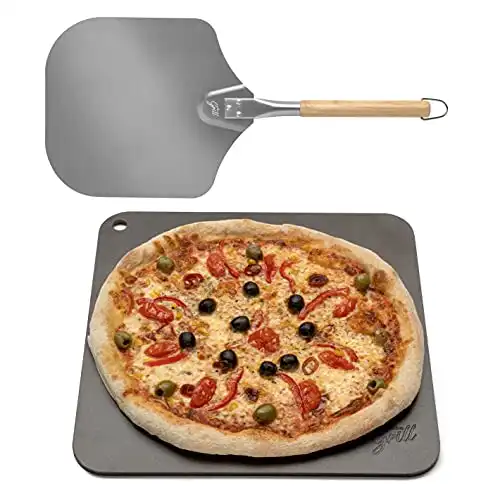
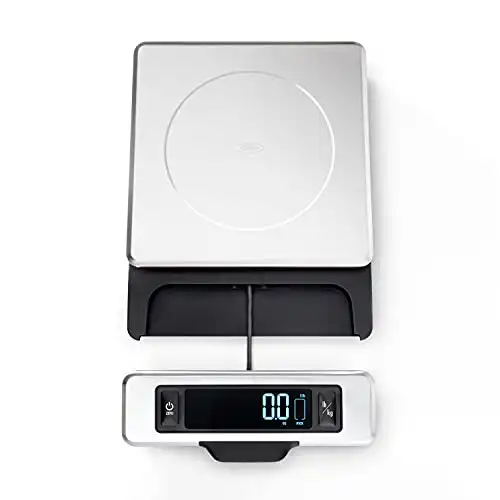
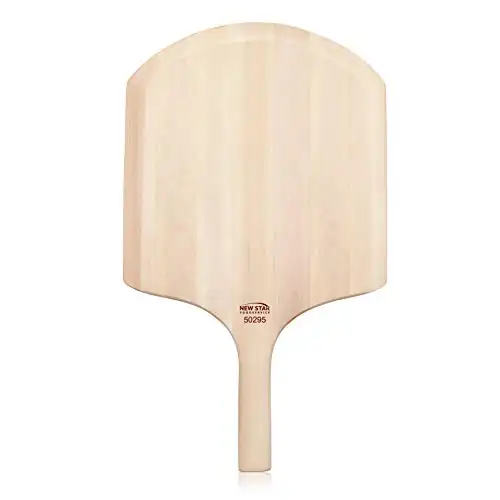
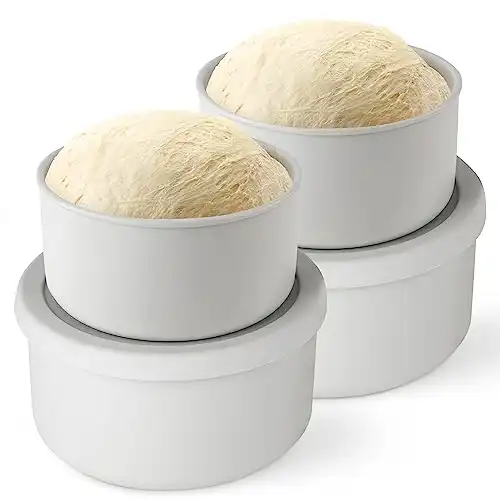
I’m sorry, I meant to say Maria!
Hi Rose! Kudos for an amazing crust and pizza! I followed your instructions to the exact measurements including investing in a scale. I was worried when I added olive oil at the end that it was going to be too greasy but after the 3 days rise in fridge, it was perfect. I didn’t even have to grease the containers! Tonight I made 2 of the pizzas (which were amazing) and now I’d like to freeze the other balls. Do I just put them in ziplock bags as is in freezer? I dusted them with flour but not sure how to store in freezer. Thank you again!!!!!!
Jane
Hi Jane, yes, just place them in ziplock bags in the freezer. On the morning of the bake, place the bags in the refrigerator to defrost. you may need to use more flour as the balls will be wet after defrosting. Don’t re-knead, just dust the top and bottom with flour as needed
Thank you so much Marie!!! My family loves your recipe!!! Do you have a recipe for your sauce?
I just wanted to update for anyone else that encounters the same problem that all my crusts came out just fine 🙂 It was sticky enough that it was all over my hands but the chilled/frozen & defrosted dough was much more smooth; I am about to make a 2nd batch (we are eating soooooo much pizza and so happy about it!) and am not going to add any more flour, just maybe dust my hands a little more while dividing it.
Also 450F on a black cookie sheet for 12 or so minutes seems to be the sweet spot.
I bought dedicated 1 liter containers this morning so that I can just brush the inside with oil instead of pouring some into a bag (I don’t have cooking spray).
Thank you again for this recipe!
I’m not sure what happened when I made this dough. I put it in the fridge and it didn’t really rise at all, even after like 5 days, so I took it out of the fridge and that’s when it really started to rise at room temp. Unfortunately, all I had to use was a metal pizza pan, because I didn’t have a stone. The pizza looked nice, but the crust was extra thick, but chewy … thicker than I wanted and not so crispy on the bottom, but I figured that had to do with the fact that I didn’t have a pizza stone. Overall, the crust was tasty, but it was nothing close to the NY style that I was craving.
I’m not sure what happened Olivia – keep trying though! you can post your process with pictures and send to me for help if you’d like. it’s hard to trouble shoot via web comments, but i’m happy to try and help.
I made up this dough this afternoon and am very excited to try it. My usual recipe is too yeasty and bread like for me although my husband loves it. I measured all the ingredients to the gram and followed the directions exactly, except for using my stand mixer on low in place of kneading, because of some health issues. The finished dough was 77F and weighed out to approx 4 portions of 325 grams each but it was SO Sticky! I made “balls” as well as I could and put 3 in oiled bags in the fridge (one has been on the counter for tonight already, sorry!) but I’m afraid I should have added more flour or kneaded some more in by hand for a minute at the end. I used all purpose organic store brand flour though I am in Europe and don’t know what the protein content is. I am hoping these still come out – I don’t have a pizza stone yet and my oven doesn’t go that high – but for the future, would you recommend adding a bit more flour? I’m sure my room temperature water and flour were measured right but it was so sticky and not smooth or glossy at all.
Hi Rose, It’s hard to say because I don’t know just how sticky the dough was. The protein content of the flour is very important. It is the main ingredient in the dough and so if the flour isn’t right, it will not work well. Higher protein flours absorb more water so if the dough was too sticky, it just might mean the protein content was too low…But in general, if the dough is just too sticky to handle, yes, I would put a tablespoon extra of flour to see if that helps. Good luck, and keep trying with different flour if this one doesn’t work.
Note: look at the difference in AP flours here to get an idea of the variation out there. I often use King Arthur All purpose flour, which really has enough gluten to call it bread flour.
Thank you! The pizza I baked yesterday came out very well, I baked it on a cookie sheet for 15 minutes at 450F but I think that was a little long. I’ll need to experiment with the flour and cooking times but I think I’ve found my pizza crust recipe 🙂 the balls/lumps in the fridge are showing some bubbles on the bottom so that bodes well too I think.
Thank you Marie! You saved me a lot of time trying to get a dough just right. Your recipe was excellent!
I never comment on websites – but I simply have to (have to!) say that this recipe is Incredible! After messing about with dozens of pizza dough recipes over the years, this is the best! I make the dough in the middle of the week – throw it in the fridge, forget about it for a couple of days – pull it out over the weekend and watch the family’s eyes light up! 🙂 Pizza’s are amazing – every time.
Ok! I’ve got my pizza crust in the fridge. I’m trying this for our son’s 3rd birthday party in a few days. I’m wondering if you have an amazing NY style pizza SAUCE to pair with this crust? I have one I will try but thought you may have a suggestion. Thanks!!
Hi Janelle – this is a pizza sauce recipe on this site that you can try. The most important part is finding a tomato sauce brand that you like because that can make or break your sauce. There are a few brands that I recommend in my sauce recipe post. Hope you like it!
Thank you so much for this great recipe!!! This might just be the best pizza I have ever ever and its home made!! I realised how popular it must be when it took me nearly a week to scroll down to the bottom of the comments. I didn’t have a pizza stone so just put it on to a lightly floured baking tray and also my oven doesn’t get as hot as 550 (480 max) but this still came out brilliantly. Thanks again!
A great recipe, but you sort of overlook alot of basic biology.
HOw much yeast you add will affect how much your dough rises, but that ‘extra’ yeast won’t affect flavor unless you add so much yeast that the flavor of the yeast starts to predominate. That would be a lot of yeast. Yeast is incapable of ‘eating’ the starch in your flour. It can only consume sugar, and it can’t even consume all kinds of sugars, only the simpler, short chain sugars.
You probably don’t need a separate ‘autolyse rest’ because you’re benefitting from the autolysis that happens during the 72 hours that the dough is resting while refrigerated. You really want the gluten for authentic pizza dough. That’s why you knead the crap out of it. It’s a bonus if you get some extra gluten ‘for free’ because if autolysis.
Hi Bob – My comment about not using too much yeast has stirred some debate before. Frankly, I have tasted the difference and I feel that less is more when it comes to yeast. I learned this from Peter Rheinhart in one of this books and on the site pizzamaking.com where many folks discuss the science of pizzamaking. I don’t have a good answer to your question/comment on the science of it all, but I do know what works for me. If you like to use more yeast, I’d say go for it!
I also have some different views on beating the dough extensively – if you are going for an extended fermentation, I don’t feel it’s necessary to knead it too aggressively. Frankly, if you do, and you use a very high protein flour with an extended fermentation, your pizza may end up like shoe leather…. 🙁
Hi,
Thanks for this wonderfull pizza dough 🙂
It’s tasting amazing.
I have followed the recepie, but My dough triples in size in the refrigiator.
I don’t know whats going wrong 🙂
it could be the temperature of the refrigerator. could it be running too warm? If possible, use a lower setting closer to 34 degree F than 400 degrees. Hope that helps. Otherwise, you can try cutting down a bit on the yeast and see how that works.
This is the best homegrown pizza dough I’ve tried yet.
I halved this recipe for two dough balls, and it really worked perfectly.
Thank you so much!!
Hi Marie
LOVE your dough recipe! made it a few times…. But I do not know why it is such a gamble for it to come out right… Sometimes I have left it for 3 days and it was perfect but sometimes after 2 days it comes out over fermented and too wet to even work with! I have always been SUPER careful with measurements to the gram so I don’t know what is causing this… Any ideas?
Many Thanks
Hi Marcus – I really don’t unless the temperature of your fridge is fluctuating or maybe you are using different flour? could you possibly be forgetting the salt when it over ferments?
Hey Marie
I just have a question about the pizzas directions.
what would be best to mix the dough with before kneaded?
and also
Could you still let the dough rise in one day out of the fridge? If so how long?
Thank you so much, I really appreciate your help, because I’ve attempted to make pizzas before, but they all failed miserably ?. I hope this will be my success story, thank you.
Hi Karine – Sorry for the late reply I was away for a few days. I always use a stand mixer to mix my dough but you can also do by hand, it’s just a bit more work. I can’t answer your question about letting the dough rise on the counter because it depends on the temperature of your kitchen, the temperature of the water you use, and even the temperature of the flour. I would mix it (on a day that you aren’t in a rush) and then let it rise until almost doubled, then refrigerate it until ready to use. But honestly, the flavor is all in the overnight fermentation so if you want to do a same day dough I’d encourage you to use another recipe (which will probably be about 1 teaspoon for every 3 cups of flour)
Thank you for the recipe! We made our first batch of pizza dough tonight. We followed your recipe by weighing the ingredients. We let the dough rest in the refrigerator for 2 days. We have never made homemade pizza before so we are looking for some advice.
1. We could not get the dough to be even when rolled out. Do you have any suggestions to make this process easier? We watched the video, but our dough would not stretch out. It would shrink back. Ultimately, the middle was too thin, and the edges were too thick. Help!
2. We cooked the pizza in a pizza oven at about 700 degrees. There were a lot of bubbles when it cooked. Can we do anything to reduce the bubbles?
Thank you so much for your advice! We are excited to try it again.
Hi Ashley – sorry for the late reply. If you are using coldish dough that will definitely cause more bubbling. Otherwise, toppings usually reduce the bubbling or as a last resort, you can try docking the dough by pricking it all over with a fork.